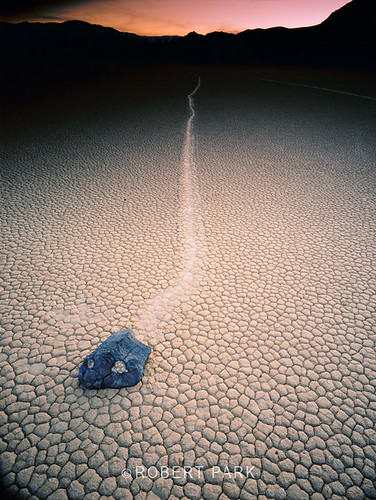
"Night Crawler" Death Valley National Park,California By Robert Park http://www.robert-park.com, a photo by Robert Park Photography on Flickr.
"Night Crawler" Death Valley National Park,California By Robert Park http://www.robert-park.com
The playa is in the small Racetrack Valley endorheic basin between the Cottonwood Mountains on the east and Nelson Range to the west. During periods of heavy rain, water washes down from the mountains onto the playa, forming a shallow, short-lived endorheic lake. Under the hot desert sun the thin veneer of water quickly evaporates leaving behind a surface layer of soft slick mud. As the mud dries it shrinks and cracks into a mosaic pattern of interlocking polygons. The shape of the shallow hydrocarbon lake Ontario Lacus on Saturn’s moon Titan has been compared to that of Racetrack Playa. The Racetrack is a unique attraction of Death Valley National Park that not many park visitors get to see. It’s a dry lakebed in a very remote and beautiful area. On the north end of the lakebed is a rock formation known as the grandstands. Rocks from the grandstands and other nearby formations break off and fall onto the lake. There, they perform feats that make this remote playa world-famous. The evidence that they move is the trails they leave behind them as they scoot around the lake. You ’ll find a rock sitting innocently anywhere on the playa — from next to the grandstand to the far southern edge — and behind it will be a trail, from the rock sliding across the fine clay surface of the lakebed. They move! But after all these years, a hundred or more since this phenomenon was brought to the attention of naturalists studying Death Valley, no one has ever seen them move. These rocks aren’t boulders; most are perhaps a foot or so tall, but can still weigh a lot and are not easy to lift.Location The Racetrack Death Valley National Park, California
© Robert Park
www.robert-park.com/
No comments:
Post a Comment